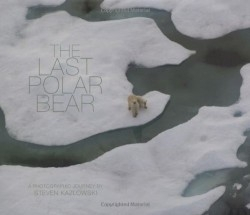The Last Polar Bear
Facing the Truth of a Warming World
Global warming, a concept once under the sole jurisdiction of overeager environmental activists, has lately developed into an issue nearly universally accepted as a major problem in dire need of universal human attention.
Nevertheless, as often as climate change appears in the news, it remains a difficult concept to grasp with the right balance of emotion and reason. In The Last Polar Bear, photographer Steven Kazlowski has struck just the right chord.
By combining lively photographs of polar bears and other Arctic wildlife with essays from articulate experts, Kazlowski has produced a book that presents both a call to the heart and a call to arms. Readers will be hard pressed to ignore the twinge of accountability accompanying purchases, whether it be a new car or a styrofoam cup of coffee. Kazlowski gives climate change a face: a cute, white, furry face with a black nose. A face in danger of extinction because its home is melting.
This is not Kazlowski’s first book of wildlife photography. He has previously displayed his keen eye and patient resolve in Bears of North America and Alaska Wildlife Impressions. He also contributes to a number of magazines, such as TIME, Audubon, and National Geographic For Kids.
As evidenced by the images and journal extracts included in The Last Polar Bear, he works long hours and endures extreme conditions. Camping in minus 20-degree weather while waiting for a polar bear mom to emerge from her den with her cubs is par for the course. Photos like the one of two bear cubs peeking over their snoozing mother, or of the mother and cub forming a lonely line of two across a barren sweep of ice, invite the viewer into this frigid world where existence requires both determination and durability.
The essays accompanying the stunning photographs are, in addition to being rich in information, accessible. Occasionally, climatology can be a dense, difficult read for the uninitiated.
Not here. Writers like Daniel Glick, Charles Wohlforth, Richard Nelson, and Nick Jans use personal anecdotes and creative metaphors to examine the cause, effect, and some possible solutions to climate change.
Glick, for instance, provides a detailed explanation of the problem by equating global warming to the earth’s having a fever of unknown origin, noticed by discerning scientists like Svante Arrhenius as early as 1896. Of course, few heeded his warning that the earth may warm up due to burning coal, and it wasn’t until nearly a hundred years later that NASA scientist James Hansen placed blame for the rising temperature squarely in the collective human lap. Richard Nelson relates his experiences with the Inupiaq people, who live in the northernmost reaches of Alaska and share the ice with polar bears.
As a graduate student who had never hunted, traveled by dog sled, or encountered a polar bear in the wild, Nelson found himself warmly welcomed by villagers willing to initiate him. An old man known as the greatest Inupiaq hunter tells him a story about hunting a polar bear on the ice by pretending to be a seal and convincing the polar bear to hunt him. For hundreds of thousands of years, the Inupiaq and the polar bears have survived together and learned from each other in the harshest conditions on earth.
Stories like this show why climate change needs to be seriously addressed. The ice on which the Inupiaq and the polar bears make their living is melting, quickly. People and animals living in the northernmost reaches of the world are watching. Ice forms later in the year and melts earlier, which affects the amount of time a polar bear mother has to keep her cubs close and protected in a frozen winter den. Drowned polar bears are becoming a common sight, as the distance between ice shores stretches too far for the creatures to swim.
By revealing the immediate impact of climate change—what’s happening now, instead of what may theoretically happen—on polar bears, the Inupiaq, and other arctic inhabitants, Steven Kazlowski and the writers included in The Last Polar Bear have produced an enduring lesson plan on how to recognize and help cure the earth’s fever.
The clearest message a reader will gain from this book? Despair is not an option. Only through hope will we change the world.
Reviewed by
Andi Diehn
Disclosure: This article is not an endorsement, but a review. The publisher of this book provided free copies of the book to have their book reviewed by a professional reviewer. No fee was paid by the publisher for this review. Foreword Reviews only recommends books that we love. Foreword Magazine, Inc. is disclosing this in accordance with the Federal Trade Commission’s 16 CFR, Part 255.

